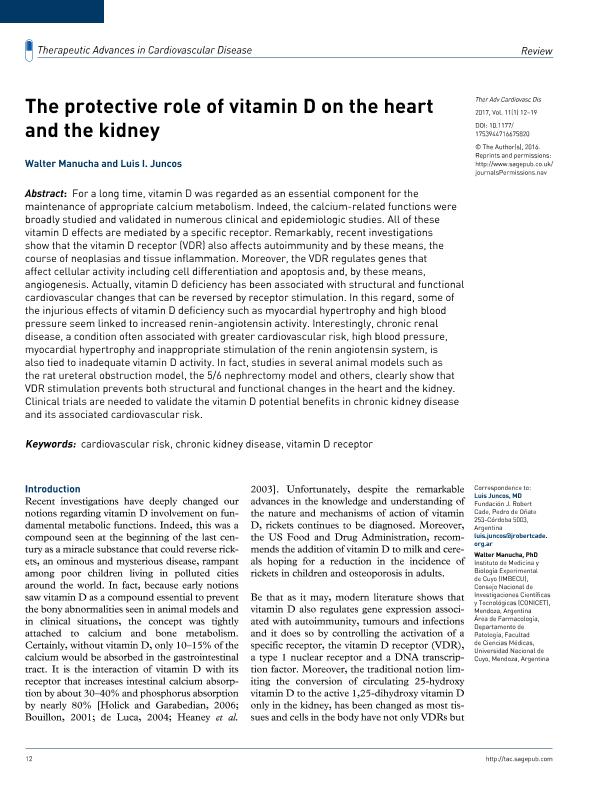Artículo
The protective role of vitamin D on the heart and the kidney
Fecha de publicación:
01/2017
Editorial:
SAGE Publications
Revista:
Therapeutic Advances in Cardiovascular Disease
ISSN:
1753-9447
e-ISSN:
1753-9455
Idioma:
Inglés
Tipo de recurso:
Artículo publicado
Clasificación temática:
Resumen
For a long time, vitamin D was regarded as an essential component for the maintenance of appropriate calcium metabolism. Indeed, the calcium-related functions were broadly studied and validated in numerous clinical and epidemiologic studies. All of these vitamin D effects are mediated by a specific receptor. Remarkably, recent investigations show that the vitamin D receptor (VDR) also affects autoimmunity and by these means, the course of neoplasias and tissue inflammation. Moreover, the VDR regulates genes that affect cellular activity including cell differentiation and apoptosis and, by these means, angiogenesis. Actually, vitamin D deficiency has been associated with structural and functional cardiovascular changes that can be reversed by receptor stimulation. In this regard, some of the injurious effects of vitamin D deficiency such as myocardial hypertrophy and high blood pressure seem linked to increased renin-angiotensin activity. Interestingly, chronic renal disease, a condition often associated with greater cardiovascular risk, high blood pressure, myocardial hypertrophy and inappropriate stimulation of the renin angiotensin system, is also tied to inadequate vitamin D activity. In fact, studies in several animal models such as the rat ureteral obstruction model, the 5/6 nephrectomy model and others, clearly show that VDR stimulation prevents both structural and functional changes in the heart and the kidney. Clinical trials are needed to validate the vitamin D potential benefits in chronic kidney disease and its associated cardiovascular risk.
Palabras clave:
Cardiovascular Risk
,
Chronic Kidney Disease
,
Vitamin D Receptor
Archivos asociados
Licencia
Identificadores
Colecciones
Articulos(IMBECU)
Articulos de INST. DE MEDICINA Y BIO. EXP. DE CUYO
Articulos de INST. DE MEDICINA Y BIO. EXP. DE CUYO
Citación
Manucha, Walter Ariel Fernando; Juncos, Luis Isaias; The protective role of vitamin D on the heart and the kidney; SAGE Publications; Therapeutic Advances in Cardiovascular Disease; 11; 1; 1-2017; 12-19
Compartir
Altmétricas




